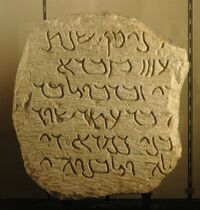Social:Palmyrene Aramaic
| Palmyrene Aramaic | |
|---|---|
 | |
| Region | Syrian Desert |
| Extinct | 1st millennium |
Afro-Asiatic
| |
Early forms | Proto-Afroasiatic
|
| Palmyrene alphabet | |
| Language codes | |
| ISO 639-3 | – |
qhy-pal | |
| Glottolog | None |
Palmyrene Aramaic was a primarily Western Aramaic dialect, exhibiting Eastern Aramaic grammatical features and hence often regarded as a dialect continuum between the Eastern and Western Aramaic branches.[1][2][3] It was primarily documented in Palmyra itself, but also found in the western parts of the Roman Empire, extending as far as Britannia. Dated inscriptions range from 44 BCE to 274 CE, with over 4,000 known inscriptions, mostly comprising honorific, dedicatory, and funerary texts. The dialect still retains echoes of earlier Imperial Aramaic. The lexicon bears influences from both Koine Greek and, to some extent, Arabic.[4][5][6]
The dual had disappeared from it.[4]
The written Palmyrene language was composed in a rounded script that later exhibited resemblances to the Syriac Estrangela script.[7]
See also
- Middle Aramaic dialects
- Palmyrene Empire
References
- ↑ (in German) Tempus, Aspekt und Modalität im Reichsaramäischen. Harrassowitz. p. 47. "While the East Aramaic Palmyrene language seamlessly supplanted Imperial Aramaic as the language of Palmyra, likely in the second century BCE.…"
- ↑ Aramaic Inscriptions and Documents of the Roman Period. OUP Oxford. p. 43. "…Palmyrene was a continuation of Official Aramaic and a close reflection of the spoken language of the Palmyrene region, with eastern Aramaic features…."
- ↑ Hellenistic and Roman Greece as a Sociolinguistic Area. John Benjamins Publishing Company. p. 271. "…Palmyrene Aramaic has preserved many old Aramaic features; on the other hand, it also shows isoglosses with the eastern dialects…"
- ↑ 4.0 4.1 Charles Fontinoy (1969) (in fr). Le duel dans les langues sémitiques. p. 76. ISBN 9782251661797. https://books.google.com/books?id=DiqPkJFFG48C.
- ↑ Sebastian P. Brock: Greek and Latin Words in Palmyrene Inscriptions: A Comparison with Syriac, in: Eleonora Cussini (Hrsg.): A Journey to Palmyra. Collected Essays to Remember Delbert R. Hillers (= Culture and History of the Ancient Near East 22). Brill, Leiden 2005, 11–25; Holger Gzella: Die Palmyrener in der griechisch-römischen Welt. Kulturelle Begegnung im Spiegel des Sprachkontaktes, in: Klio 87 (2005), 445–458; Ders.: Das Aramäisch in den römischen Ostprovinzen. Sprachsituationen in Arabien, Syrien und Mesopotamien zur Kaiserzeit, in: Bibliotheca Orientalis 63 (2006), 15–39.
- ↑ Mohammed Maraqten: The Arabic Words in Palmyrene Inscriptions, in: ARAM 7 (1995), 89–108.
- ↑ (in English) A Corpus of Syriac Incantation Bowls. Brill. p. 15. "... Palmyrene characteristics detectable in its forms. He wrote (1962, 61) that this script may be seen as “a Syriac type evolved from an early form of Aramaic alphabet, of Palmyrene type, and which enjoys independence from the Edessene .."
Further reading
- Daniels, Peter T. (1988). ""Shewing of Hard Sentences and Dissolving of Doubts": The First Decipherment". Journal of the American Oriental Society 108 (3): 419. doi:10.2307/603863. https://www.jstor.org/stable/603863.
- Hillers, Delbert R.; Cussini, Eleonora (1996). Palmyrene Aramaic Texts. Johns Hopkins University Press. ISBN 978-0-8018-5278-7.
- Hans H. Spoer (1904). "Palmyrene Inscriptions found at Palmyra in April 1904". Journal of the American Oriental Society.
- John Swinton (1753). "An Explication of All the Inscriptions in the Palmyrene Language and Character Hitherto Publish'd. In Five Letters from the Reverend Mr John Swinton, M. A. of Christ-Church, Oxford, and F. R. S. to the Reverend Thomas Birch, D. D. Secret. R. S.". Philosophical Transactions 48: 690. Bibcode: 1753RSPT...48..690S.
 |

